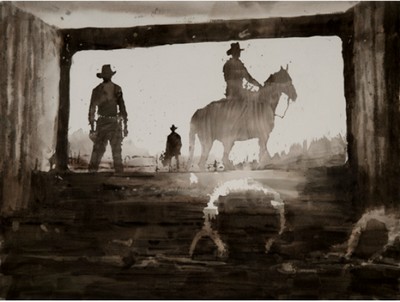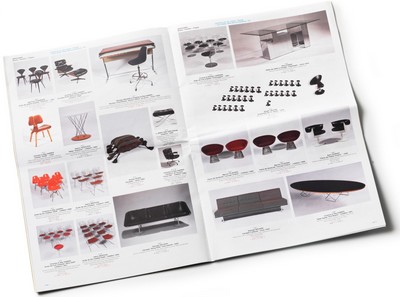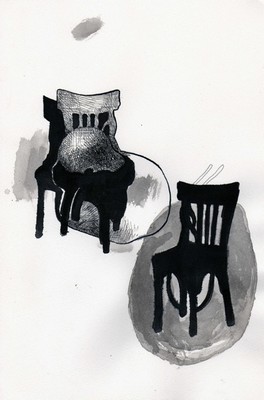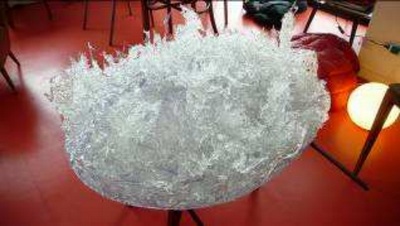Post-War & Contemporary Art Auctions
Christie’s London
16 - 17 February 2011
CHRISTIE’S AUCTIONS OF POST-WAR AND CONTEMPORARY ART will take place on 16 and 17 February 2011 in London and are expected to realise a combined total of £46,246,000 to £66,447,000 (corresponding auctions in February 2010 - £34.9 million to £50.5 million). Highlights from the Evening auction were on public exhibition at Christie’s New York from 24 to 26 January. The full auctions is on public exhibition in London from 12 to 16 February.
ANDY WARHOL AND JEFF KOONS LEAD CONTEMPORARY MASTERWORKS
Francis Outred, Head of Post-War and Contemporary Art, Christie’s Europe: “I am very excited by the upcoming auction which is probably the strongest and most diverse we have had in London since I joined Christie’s in January 2009. Showing some of the most important art from Europe and America of the last fifty years, it also showcases the best art which has emerged across the globe over the last decade. Anchored by the re-discovery of the outstanding monumental self-portrait by Andy Warhol, it is also great to offer Jeff Koons’ seminal ‘Winter Bears’. An incredible life-like representation in wood which is child-size, this re-fashioning of the Adam and Eve story as cutesy Alpine bears clutching a heart shaped bag, where all seems too perfect to be true, represents one of Koons' greatest musings on the nature of modern relationships. It seems very apt to be offering this work in Valentine's week.”
REDISCOVERED SEMINAL LARGE SELF-PORTRAIT BY ANDY WARHOL (1928-1987)
Executed in 1967 and an addition to an historically important series of 10 self-portraits, the picture has been in a private collection since 1974 when it was acquired from Leo Castelli, Warhol’s primary dealer. It will be offered at the Post-War and Contemporary Art Evening Auction on Wednesday 16 February 2011 in London and is expected to realise £3 million to £5 million. The picture was exhibited in public for the first time at Christie’s New York from 22 to 26 January 2011.
The present work is one of an historic series of 11 large-scale self-portraits executed in 1967, five of which are in museums (Tate, London; The Staatsgalerie Moderne Kunst, Munich; the San Francisco Museum of Modern Art; and two at the Detroit Institute for Arts). Such is the importance of the series that eight of the known works were included in the artist’s landmark retrospective at MOMA two years after his death in 1989. The present work is completely unpublished and has been in the same private collection since 1974.
Francis Outred, Head of Post-War and Contemporary Art, Christie’s Europe: “I’m incredibly excited at the prospect of offering this rediscovered masterpiece by Andy Warhol. At the time of its execution Warhol was at the peak of his creative powers and this very rare series of works were the largest self-portraits he had made. This work shows a classic image of the artist in an imposing, larger than life scale, with an extraordinary presence of thick, red paint. That 5 of the works from this series are in museums is a testament to their importance.”
The image of Warhol with his hand to his mouth is one of the most representative and iconic images of the artist. Warhol first used the image for a group of works in 1966 painted in a much smaller, life-size scale. The following year he used the same image in producing 11 monumental works in a large-scale format of six foot square, of which the present example is one. Six works from this series were exhibited in the American Pavilion at the 1967 International and Universal Exposition in Montreal which was visited by tens of millions of people, and which saw the portraits dominate an exhibition including works by Jasper Johns, Roy Lichtenstein, Barnett Newman and Robert Rauschenberg.
By 1967 Warhol had reached a point in his career when he was internationally recognized as the most important and controversial figure in American Pop Art. The present series of self-portraits represent the high point of his career when he has achieved great wealth and fame, and when as a celebrity he brashly and confidently presented his own image in a truly monumental fashion to a global audience of millions.
SEMINAL WORK FROM JEFF KOONS
Another leading highlight is Winter Bears, 1988, a seminal work from Jeff Koons (b. 1955) highly acclaimed Banality series which launched him as an international art star in the late 1980s. At over 120 cm in height, the pair of child-sized sculptures, with their wide eyes, matching ‘his and hers’ clothing and cartoonish faces, wave to us and welcome us into the distinct world of Jeff Koons. If the Banality series was Koons’ idealised human civilisation or ‘Garden of Eden’, the Winter Bears represented Adam and Eve, the perfect depiction of human unity, as an Alpine European couple. Painstakingly carved out of wood which has then been polychromed in the traditional manner redolent of the great Medieval church sculpture in Germany, Koons has here lent a human and spiritual air to a cartoon-like creation. Their size and physicality lends them a thoroughly human quality which begins to jar the lines between cartoon and reality, and high and low art. Offered at auction for the first time having been in the present collection since 1994, it is expected to realise £2.5 million to £3.5 million. Another version of Winter Bears resides in the collection of the Tate Modern in London.
OTHER HIGHLIGHTS OF POST-WAR AND CONTEMPORARY ART EVENING AUCTION
Dina Amin, Director and Head of Evening Auction: “The global personality of the sale is reflected in works from China, Brazil, India and Iraq as well as major works from America and Europe. We are particularly pleased to have strong representations of Eduardo Chillida, Gerhard Richter and Lucio Fontana, alongside an extremely rare pioneering portrait by Martial Raysse.”
Italy
The dawn of conceptual art is represented at the auction through two Italian pioneers of the movement; Lucio Fontana (1899-1968) and Piero Manzoni (1933-1963). In the late 1950s and early 1960s, these two artists transformed the landscape of contemporary art with works that went on to inspire, among others, Warhol, Koons, Hirst and Gursky.
Concetto spaziale, 1961, by Lucio Fontana (1899-1968) is a sumptuous symphony of gold which explores the ideas and concepts of space and the immaterial in the same year that Yuri Gagarin would become the first man in space. From the artist’s breakthrough series Olii, which includes the celebrated Venice series of the same year, the present work relates very closely to Concetto spaziale, Venezia era tutta d’oro, now in the Museo Thyssen-Bornemisza, Madrid. It is expected to realise £2 million to £3 million. Also by the artist, Concetto spaziale, Attesa was executed in 1964 and is a beautiful, crisp minimalist work in white which emphasizes the purity of the slash against a background reminiscent of Manzoni, whom he had strongly influenced and who had died the previous year. It is expected to realise £1 million to £1.5 million.
Achrome by Piero Manzoni (1933-1963) is an early, majestic example of the artist’s most celebrated series of works. Executed in 1958-59, it is of a relatively large scale of 60cm by 80cm and is offered at auction for the first time. Created through the marriage of soaked kaolin and canvas, the work has been allowed to develop autonomously to mesmerizing effect. It is expected to realise £1.8 million to £2.5 million.
United States
Untitled by Jean-Michel Basquiat (1960-1988) is an important, early work executed in 1981, the year in which the artist moved from the street to the studio. Acquired by the current Italian owner circa 1982, the year after it was painted, this important, early and rarely seen work captures the raw energy and power of the artist before his star rose in the art world. It is expected to realise £1 million to £1.5 million. ‘While I was there looking at the painting [the present work], the owner came closer to me and said: ‘When Basquiat knew that the painting was here, he came back to see it again. As soon as he saw the painting, he started crying. He said that he would never be able to do paintings like this again’ (T. Lo Porto, quoted in Phoebe Hoban, ‘Vita Lucente e Breve di un Genio dell’arte’, Rome, 2006).
France
L'année dernière à Capri (titre exotique) by Martial Raysse (b. 1936) is one of the artist’s most important works. Painted in 1962, it captures the point at which Nouveau Réalisme the movement that he pioneered, met with Pop Art in striking fashion. An exceptionally early milestone from the early history of Pop Art, this vibrant, larger than life work measures 184cm x 134.6cm and is offered at auction for the first time having been in the same private collection since circa 1975. It is expected to realise £1 million to 1.5 million with proceeds to benefit a charitable Foundation.
UK
Branded by Jenny Saville (b. 1970) is an epic, early portrait measuring 7 foot in height and 6 feet in width. Painted in 1992, it was one of the first works by the artist acquired by Charles Saatchi as he began to champion her work and it was subsequently exhibited in 2000 at the National Portrait Gallery’s Painting the Century: 101 Portrait Masterpieces 1900-2000. It was acquired at auction by the present owner in 2000 for a then world record price for the artist and is expected to realise £700,000 to £1,000,000.
Arginine Decarboxylase by Damien Hirst (b. 1965) was executed in 1994, the year that he was nominated for the Turner Prize, and is one of the largest of the artist’s early, celebrated spot paintings. It is expected to realise £400,000 to £600,000.
Germany
Athanor by Anselm Kiefer (b. 1945) is a haunting and provocative presentation of a Reichstag-like building as a vast, ruined and burnt-out brick oven painted in 1991, the period soon after German reunification. A monumental and highly important work that represented both a warning and an image of hope and possibility to the German people, it is expected to realise £800,000 to £1,200,000.
Gerhard Richter (b. 1932) is widely regarded as the father of post-modern painting and the auction will offer 4 of his works each from different, influential periods in his career:
o Stadtbild, is an almost abstract townscape painted in 1969 as the artist moved away from the photo-realist style that had dominated his output during that decade (estimate: £400,000 to £600,000).
o Gilbert & George, 1975, is one of a series of six portraits of the celebrated British artists, two of which are in museums (Tate Modern, London and National Gallery, Canberra) (estimate: £600,000 to £800,000).
o Abstraktes Bild, 1990, is a mesmerizing work that represents the pinnacle of the artist’s move into abstraction (estimate: £1 million to £1.5 million)
o Ausschnitt (Kreutz), 1971, is a masterly painting, a photo-realist depiction of a brushstroke (estimate: £1.2 million to £1.8 million).
Untitled V, 1997, by Andreas Gursky (b. 1955) is one of the most important and recognisable of the artist’s works, showing 6 rows of sport shoes – a symbol representing consumerism and popular culture in the 1990s. Executed in 1997 and measuring 4 metres in length, the present work is one of an edition of only six, another of which established a then world auction record price for the artist in 2002. Offered from an important private European collection, it is expected to realise £800,000 to £1,200,000.
Spain
The auction will offer three outstanding works by Eduardo Chillida (1924-2002), each a powerful example of the artist’s command of form and space executed in three vastly differing materials. Lo profundo es el Aire XX (How Profound is the Air XX), 1998, is carved from a vast block of translucent alabaster in such a way that it mpoetically explores and demonstrates the conceptual penetration of solid material by light and space (estimate: £600,000 to £800,000); Elogio del Vacío V (Eulogy of the Void V), 1984, is made from cor-ten steel and expected to realise £350,000 to £450,000; and Mural G-46, a large and comparatively rare clay work from 1984 carries an estimate of £300,000 to £400,000.
Tres equis, 1990, by Miquel Barceló (b. 1957) belongs to one of the most celebrated series of paintings by the artist in which he portrays images and interpretations of Bullfights. Offered from an important European collection, it is expected to realise £400,000 to £600,000.
21st century global artists
A strong group of global artists from the 21st century will be presented at the auction including works by Charti Kher from India, Yan Pei Ming from China and Adriana Vãrejao from Brazil. Parede com Incisões a la Fontana II (Wall with Incisions a la Fontana II), 2001, is an important masterpiece by Adriana Vãrejao (b. 1964), one of Brazil’s most prominent contemporary artists. The work shows a vast representation of a tiled wall which has been dramatically punctuated with slashes which recall the work of Lucio Fontana. However, these slashes allow a glimpse through to an apparently fleshy background, giving the illusion of an existence beneath the surface. One of the most important works of South American contemporary art to be offered on a global auction platform, it is expected to realise £200,000 to £300,000.
The Post-War and Contemporary Art Day Auction will take place on Thursday 17 February 2011 and will offer 215 lots with a combined pre-sale estimate of £10,246,000 to £14,507,000, with individual estimates from £10,000.
*Estimates do not include buyer's premium
Sale 7955: Post-War & Contemporary Art Evening Auction, 16 February 2011
Sale 7956: Post-War & Contemporary Art Day Auction, 17 February 2011
CHRISTIE'S LONDON
www.christies.com





















